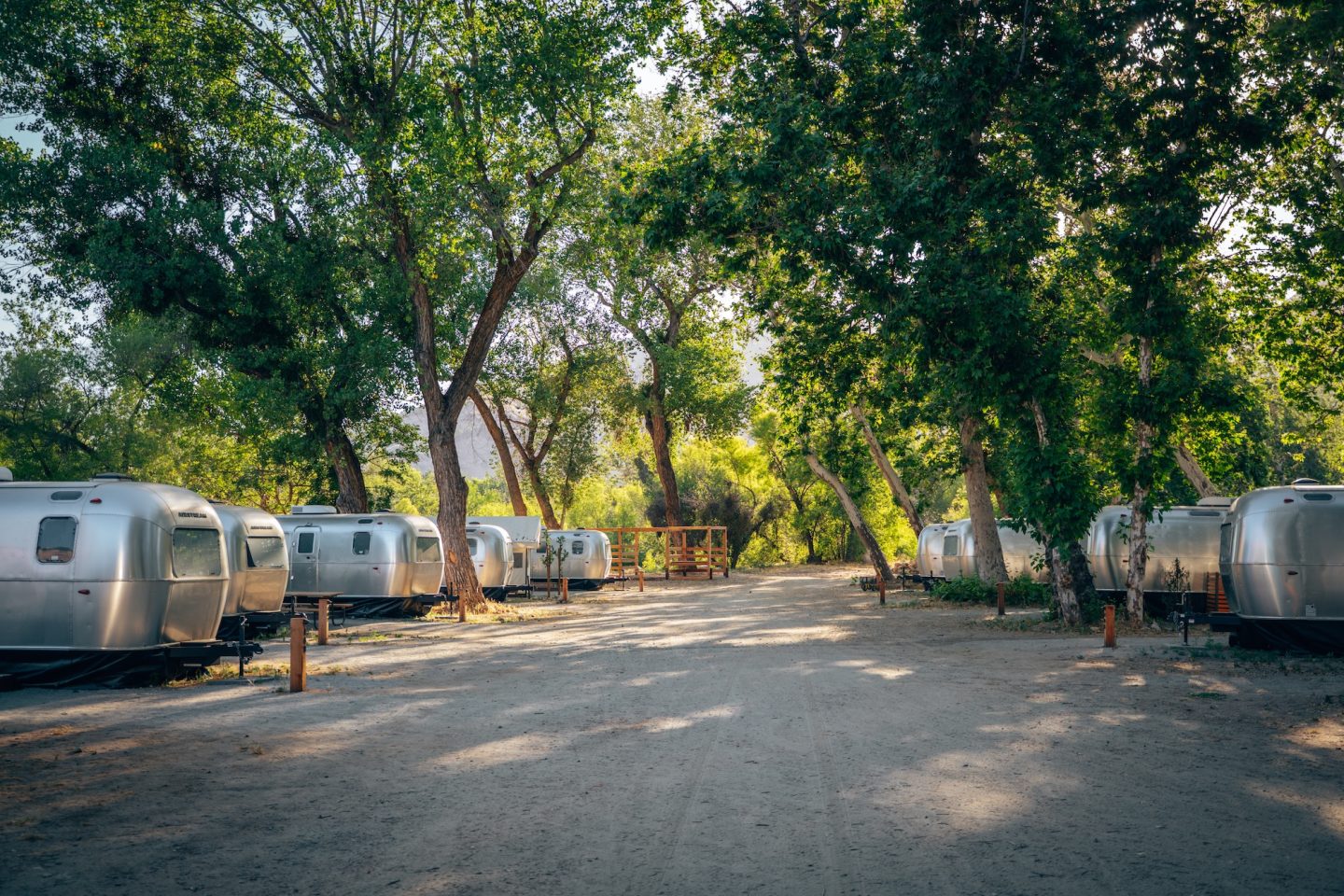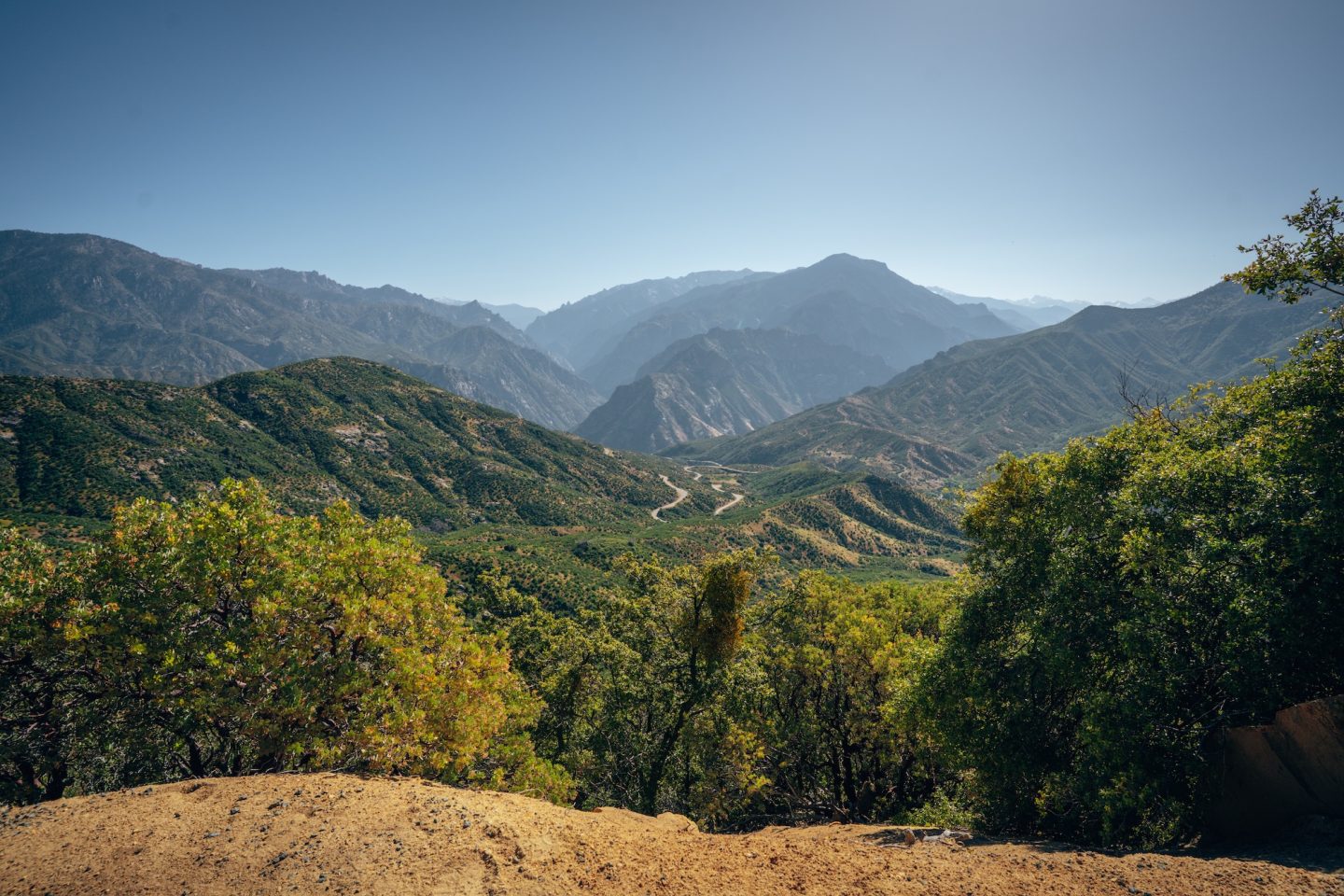
Tucked in California’s Sierra Nevada, Kings Canyon National Park is an underrated gem often overshadowed by nearby Yosemite and Sequoia National Parks. It’s home to dramatic granite cliffs, roaring waterfalls, deep canyons, and giant sequoias. It’s also an incredibly easy park to explore. If you only have one day, you can still experience the park’s top highlights without feeling rushed. This guide will help you make the most of your time with a scenic, adventure-packed one-day itinerary.
- KINGS CANYON NATIONAL PARK IN CALIFORNIA
- BEST TIME TO VISIT KINGS CANYON NATIONAL PARK
- PLACES TO STAY KINGS CANYON NATIONAL PARK
- MAP OF KINGS CANYON
- HOW TO SPEND ONE DAY IN KINGS CANYON NATIONAL PARK
- HOW TO SPEND ONE DAY IN KINGS CANYON NATIONAL PARK
- MAP OF CALIFORNIA
- LOOKING FOR MORE CALIFORNIA INSPIRATION?
KINGS CANYON NATIONAL PARK IN CALIFORNIA
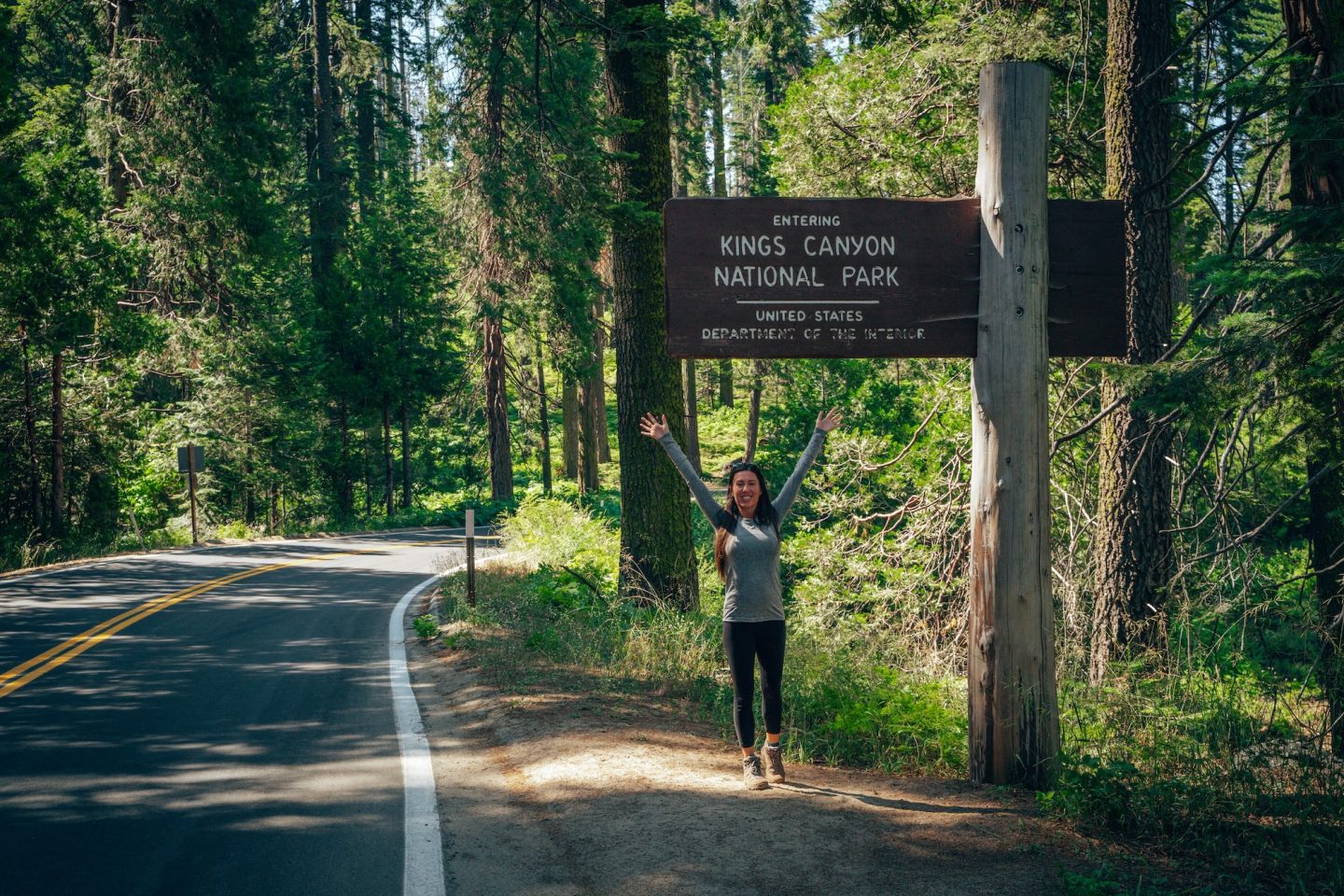
Kings Canyon National Park protects one of the deepest canyons in North America—deeper than the Grand Canyon in some spots. Carved over millions of years by glaciers and the Kings River, the park’s dramatic terrain is rich in geological history. Before it became a national park in 1940, this land was home to Indigenous peoples, including the Mono and Yokuts tribes. Today, Kings Canyon showcases a stunning mix of glacial valleys, granite cliffs, alpine forests, and ancient sequoia groves—all within one rugged, remote pocket of the Sierra Nevada.
BEST TIME TO VISIT KINGS CANYON NATIONAL PARK
The best time to visit Kings Canyon is late spring through early fall, when the roads and trails are fully open. Snow lingers into early summer at higher elevations, but wildflowers and waterfalls peak in May and June. July and August bring warmer weather and clearer access to high country hikes. By fall, the crowds thin, and the canyon’s colors start to shift with the season. Winter is beautiful but limited—many roads close, and access becomes challenging.
WEATHER IN KINGS CANYON
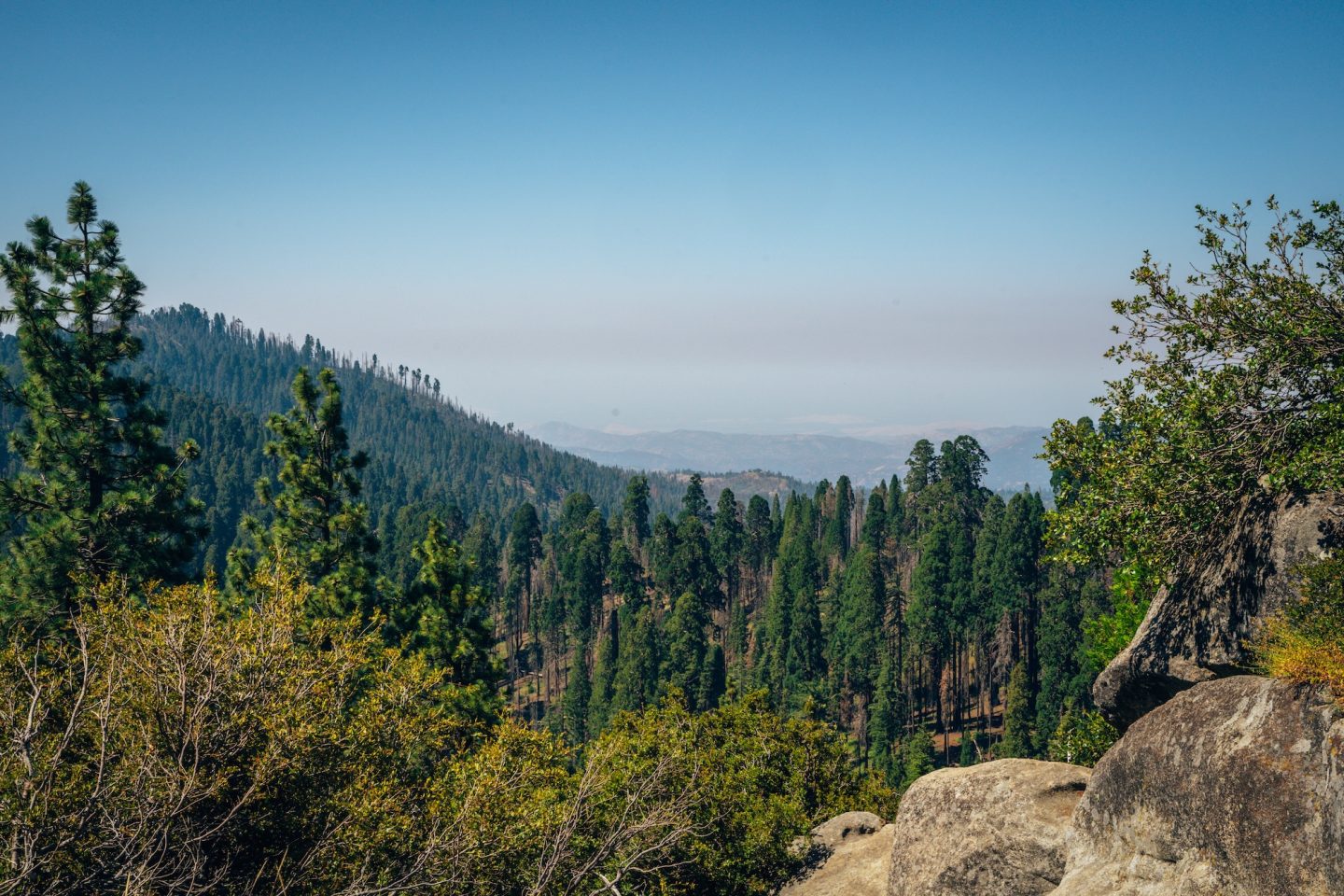
Weather in Kings Canyon varies dramatically with elevation and season, so it’s important to be prepared year-round. Summers in the canyon are warm and dry, with daytime highs often in the 80s or low 90s. Higher elevations stay cooler, offering a refreshing escape from the valley heat. Afternoon thunderstorms are possible, especially in July and August, so it’s smart to start hikes early.
In fall, temperatures begin to drop, and evenings can get chilly even in the lower canyon. Winter brings snow to the higher elevations, and the scenic Kings Canyon Scenic Byway usually closes by November. Spring starts slowly, with snowmelt feeding waterfalls and bringing wildflowers to life. Layers are key—weather can shift quickly, especially as you climb in elevation. We always recommend double checking the weather and conditions pages on the National Park pages.
SEASONAL ROAD CLOSURES & REQUIREMENTS
Road conditions in Kings Canyon change quickly—especially in fall, winter, and spring. Snow can close Highway 180 to Cedar Grove or Generals Highway anytime from November through mid‑March, often reopening only when weather permits . Chains‑required checkpoints (R‑1 to R‑3) may stop incoming cars; signage directs where to pull off and install chains safely. Even experienced drivers and AWD vehicles must carry chains when chain control is activated under California’s Vehicle Code.
Always carry chains in your vehicle during the cold‑weather season and practice installing them in advance. Rental‑car agreements may prohibit chains—opt for an AWD vehicle instead. When installed, the speed limit drops to 25 mph. Avoid pulling off in traffic lanes—use designated pullouts or parking areas as marked. See the National Park page for more info.
The last places before entering the park are either Dunlap if you’re coming from Fresno, or Three Rivers if you’re coming from the south.
VISITING KINGS CANYON NATIONAL PARK DURING THE SUMMER
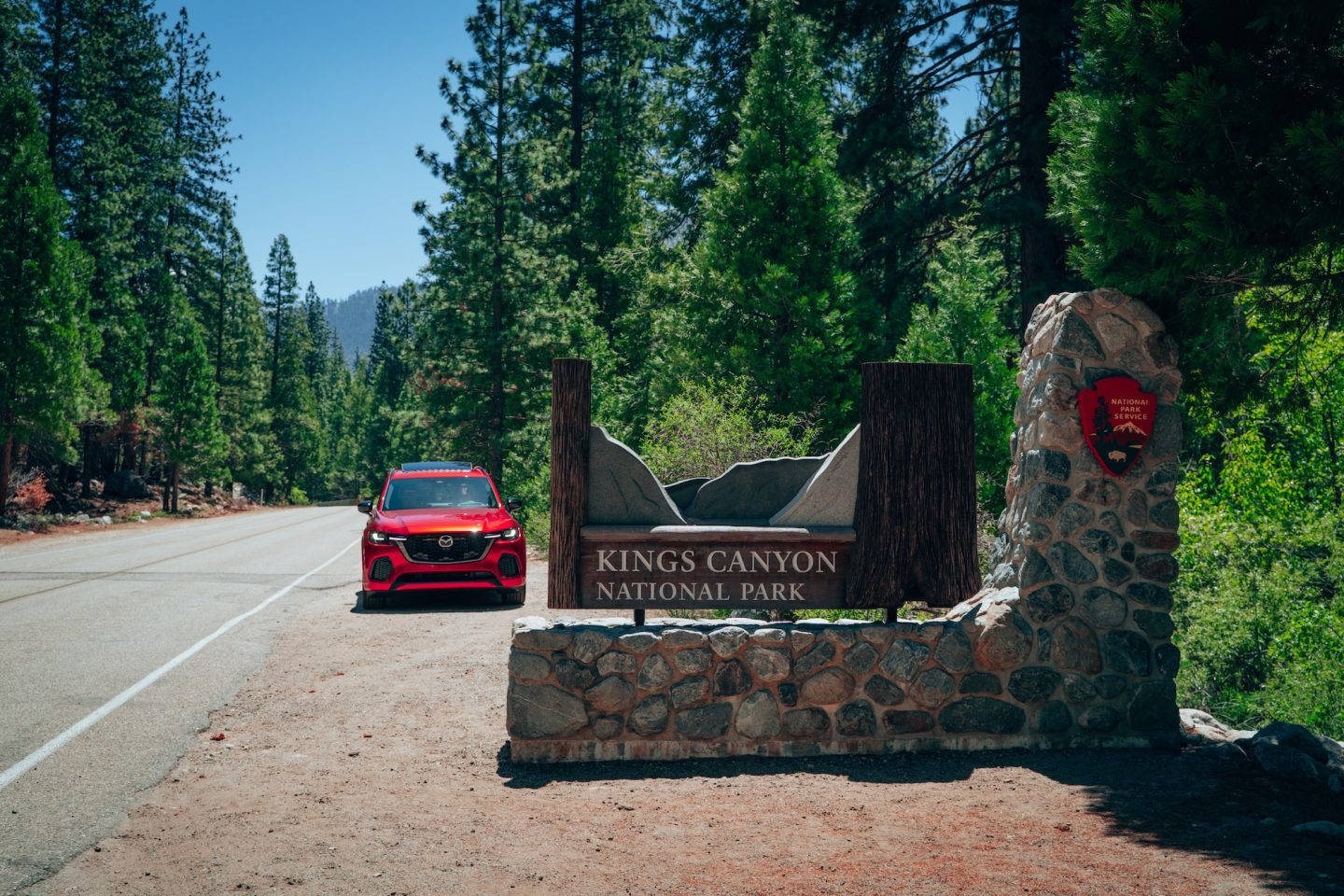
Summer is the most accessible time to visit Kings Canyon, with all park roads typically open from late May through early October. The weather is warm and dry, especially in the lower canyon, where daytime temperatures can reach the 80s or 90s. Higher elevations, like Grant Grove and Cedar Grove, stay cooler and offer a welcome escape from valley heat. All areas of the park are drivable in summer—there are no vehicle restrictions on private cars, RVs, or trailers, though steep grades and winding roads require extra caution. Unlike neighboring Yosemite, Kings Canyon does not offer a park-wide shuttle system, so visitors will need to drive themselves between sights. Parking can fill up at popular trailheads by late morning, so an early start is highly recommended.
PLACES TO STAY KINGS CANYON NATIONAL PARK
Where you stay can shape your Kings Canyon experience, from cozy cabins to convenient hotels and campgrounds. Options range from rustic lodges inside the park to charming towns nearby, offering a variety of amenities and atmospheres. Whether you prefer to wake up surrounded by towering sequoias or enjoy local dining just a short drive away, there’s something for every traveler’s style and budget. Below, we’ll explore the best places to stay both inside and outside Kings Canyon National Park.
PLACES TO STAY IN KINGS CANYON
Inside Kings Canyon, lodging options are limited but special, offering close access to nature and peaceful surroundings. The Grant Grove area hosts the historic John Muir Lodge, featuring cozy rooms and a rustic mountain atmosphere. Nearby, Grant Grove Cabins provide a more intimate, cabin-style experience steps from giant sequoias. For a classic park stay, Cedar Grove Lodge lies deep in the canyon, perfect for exploring waterfalls and river trails. Camping is also popular, with campgrounds offering a true wilderness experience. These spots fill quickly during peak season, so reservations are highly recommended.
PLACES TO STAY NEAR KINGS CANYON
Staying outside Kings Canyon offers more variety, with easier access to restaurants, gas, and year-round accommodations. Just west of the park entrance along Highway 180, towns like Dunlap and Squaw Valley have cozy cabins, inns, and vacation rentals perfect for a quiet base close to the action. Farther west, Fresno provides chain hotels and modern conveniences, ideal for travelers needing a stopover before entering the park. While Three Rivers sits closer to Sequoia National Park, it’s a great option if you’re visiting both parks in one trip. Lodging here ranges from charming riverfront cabins to full-service hotels, all within scenic driving distance.
AutoCamp Sequoia is a stylish glamping retreat in Three Rivers, just minutes from Sequoia and a scenic drive from Kings Canyon. Guests can stay in custom-designed Airstreams, luxury tents, or cozy cabins—all with modern comforts like spa-inspired bathrooms, kitchenettes, and Wi-Fi. The property features a mid-century clubhouse, riverside lounging areas, a seasonal pool, and a small café. It’s the perfect blend of nature and comfort, ideal for travelers looking to unwind in style after a day of exploring the parks.
MAP OF KINGS CANYON
Kings Canyon National Park is located in the southern Sierra Nevada of California, directly north of Sequoia National Park. The two parks are jointly managed and often explored together, with Kings Canyon offering a wilder, more remote feel. The main entrance is accessed via Highway 180 from the west, with the closest major city being Fresno, about 1.5 hours away by car. From the Bay Area, it’s roughly a 4.5-hour drive, while travelers from the Los Angeles area can expect a drive of about 5 to 6 hours depending on traffic and route. Despite its remote vibe, the park is surprisingly reachable for a weekend getaway or part of a longer California road trip.
Check out our map below to not only see exactly where Yosemite National Park and these activities are located, but over 500 other points of interest in California as well!
Not much of a planner? No worries! We also have curated itineraries to make the planning process easier for you. And if that isn’t enough, book a call with us or have us create a custom itinerary for you! We are here to help!
HOW TO SPEND ONE DAY IN KINGS CANYON NATIONAL PARK
Now that we’ve gotten through all of that, let’s jump in to the fun stuff! The things to do in Kings Canyon National Park!
GRANT GROVE
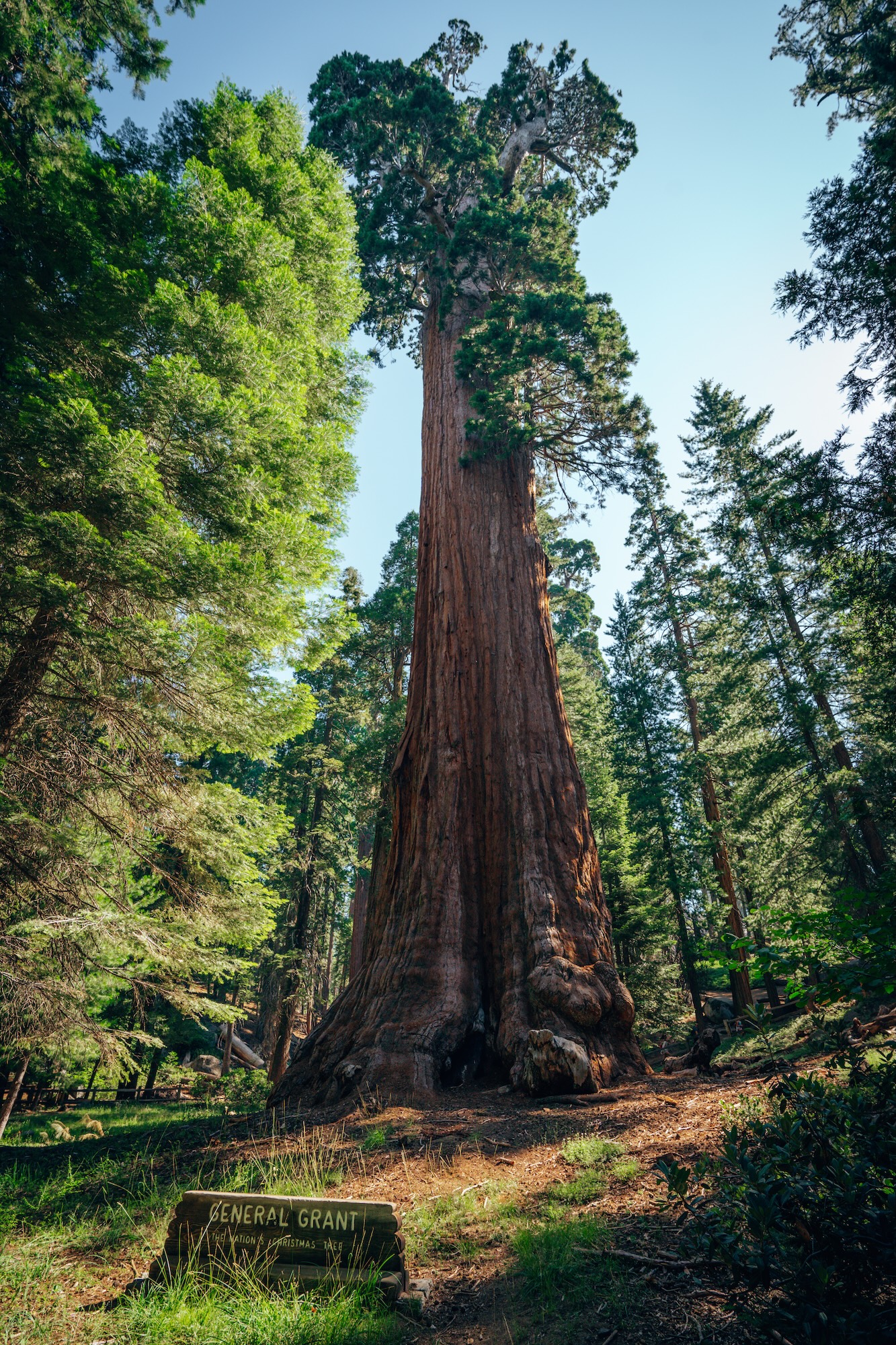
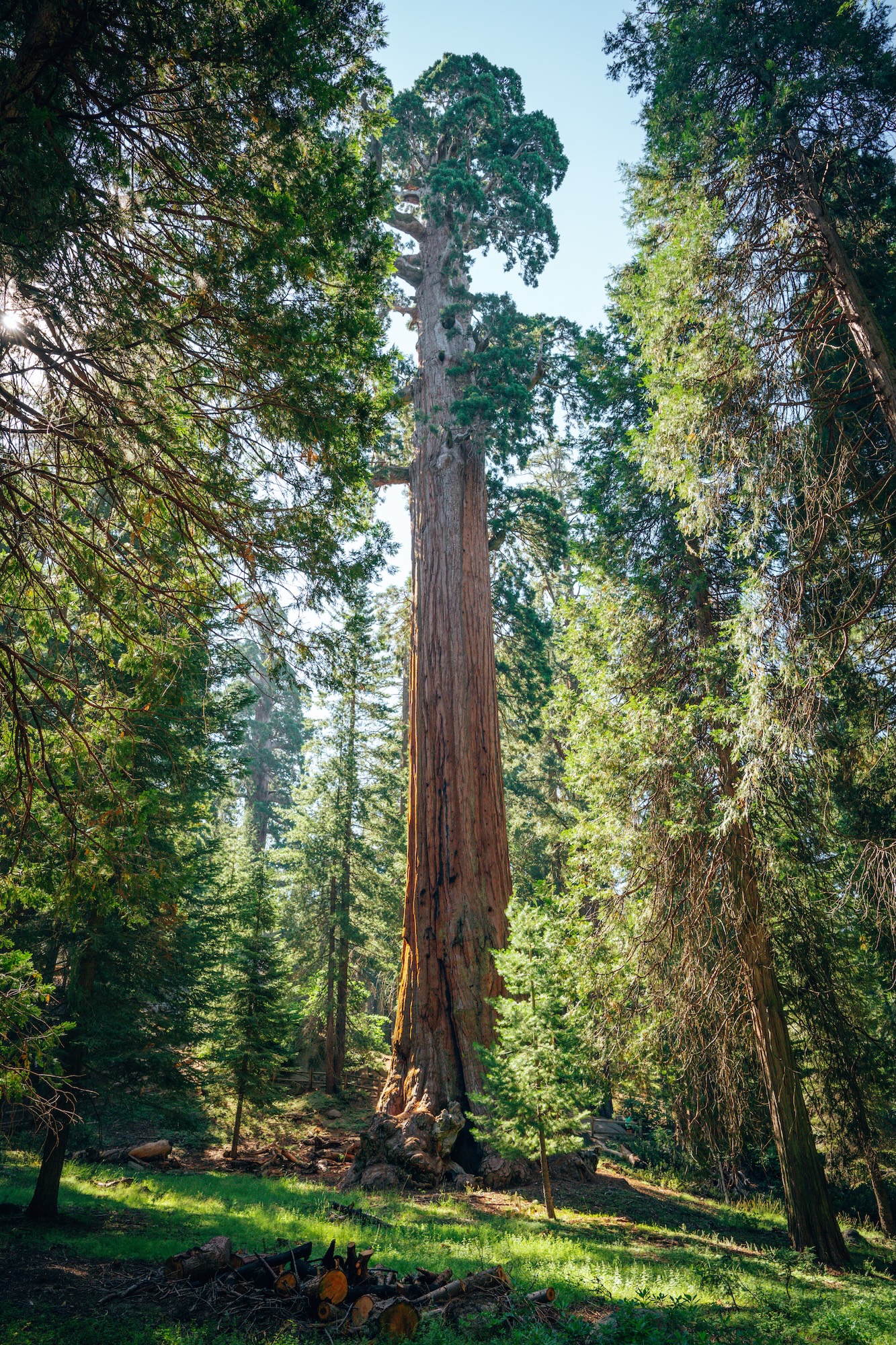
Grant Grove is one of the most iconic areas in Kings Canyon National Park, known for its dense sequoia forest and easy access. The highlight here is the General Grant Tree, the second-largest tree in the world by volume and a designated National Shrine. The General Grant Trail is a short, paved 0.7-mile loop that winds through towering sequoias, including fallen logs you can walk through and historic trees over 1,500 years old. It’s family-friendly, wheelchair accessible, and especially peaceful in the early morning or off-season. With nearby picnic areas and the Grant Grove Visitor Center close by, it’s a perfect first stop in the park.
- DIFFICULTY – Easy
- LENGTH – 0.7mi / 1.3km loop
- TIME NEEDED – 30 minutes
- PET FRIENDLY – NO
KINGS CANYON SCENIC BYWAY
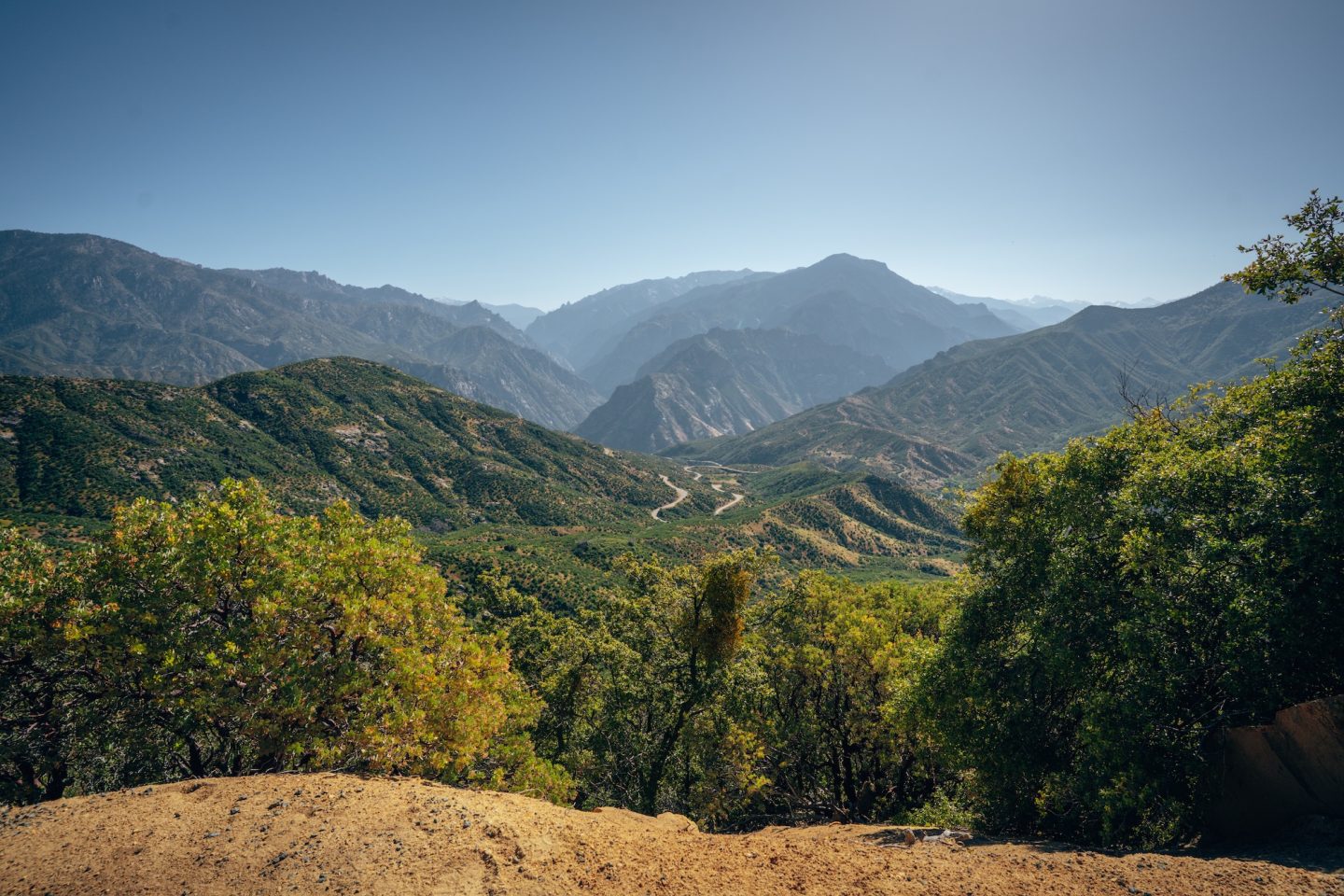
The Kings Canyon Scenic Byway is one of the most underrated drives in the Sierra, and California as a whole, taking you deep into the heart of the park. Stretching about 50 miles from Grant Grove to Cedar Grove, the road winds past granite cliffs, river-carved canyons, and cascading waterfalls. It follows the South Fork of the Kings River, with plenty of pullouts for photos, picnics, and short hikes. Along the way, you’ll pass highlights like Boyden Cavern, Grizzly Falls, Roaring River Falls and roaring canyon views that rival anything in Yosemite. Open seasonally—typically late May through mid-fall—this byway is the ONLY way to reach the stunning Cedar Grove area by car.
GRIZZLY FALLS
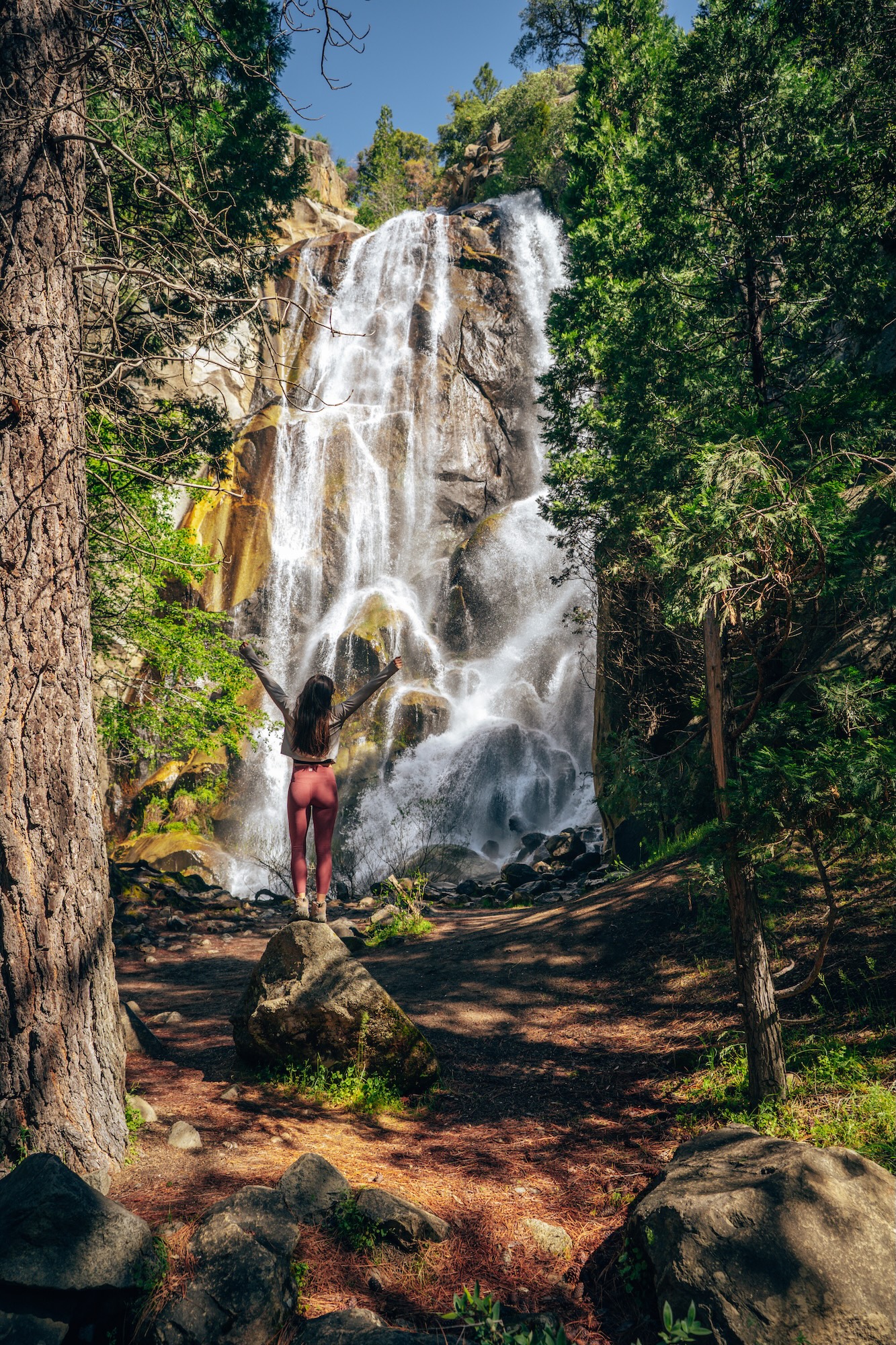
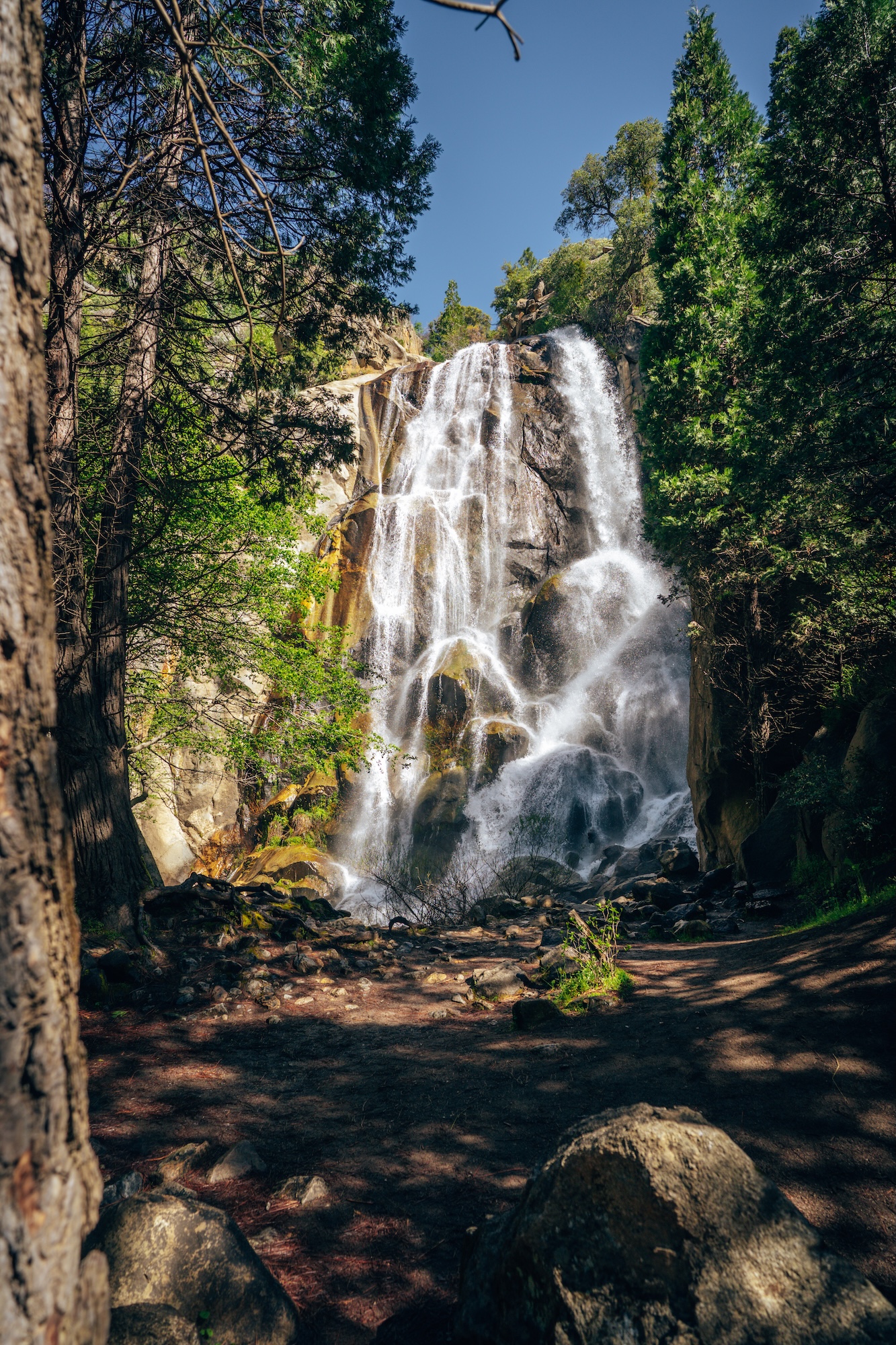
Despite not being inside of Kings Canyon National Park, Grizzly Falls is one of the easiest and most rewarding stops along the Kings Canyon Scenic Byway. There is a section of the byway that enters in and out of the Giant Sequoia National Monument. This 75-foot waterfall cascades down a granite cliff just steps from the roadside, making it perfect for a quick photo or picnic break. It’s especially powerful in spring and early summer when snowmelt is at its peak. A short, flat path leads from the parking area to the base of the falls—no hiking required. With mist in the air and towering cliffs all around, it’s a great way to experience the drama of Kings Canyon without much effort.
- DIFFICULTY – Easy
- LENGTH – 0.1mi / 0.2km loop
- TIME NEEDED – 15 minutes
- PET FRIENDLY – NO
ROARING RIVER FALLS
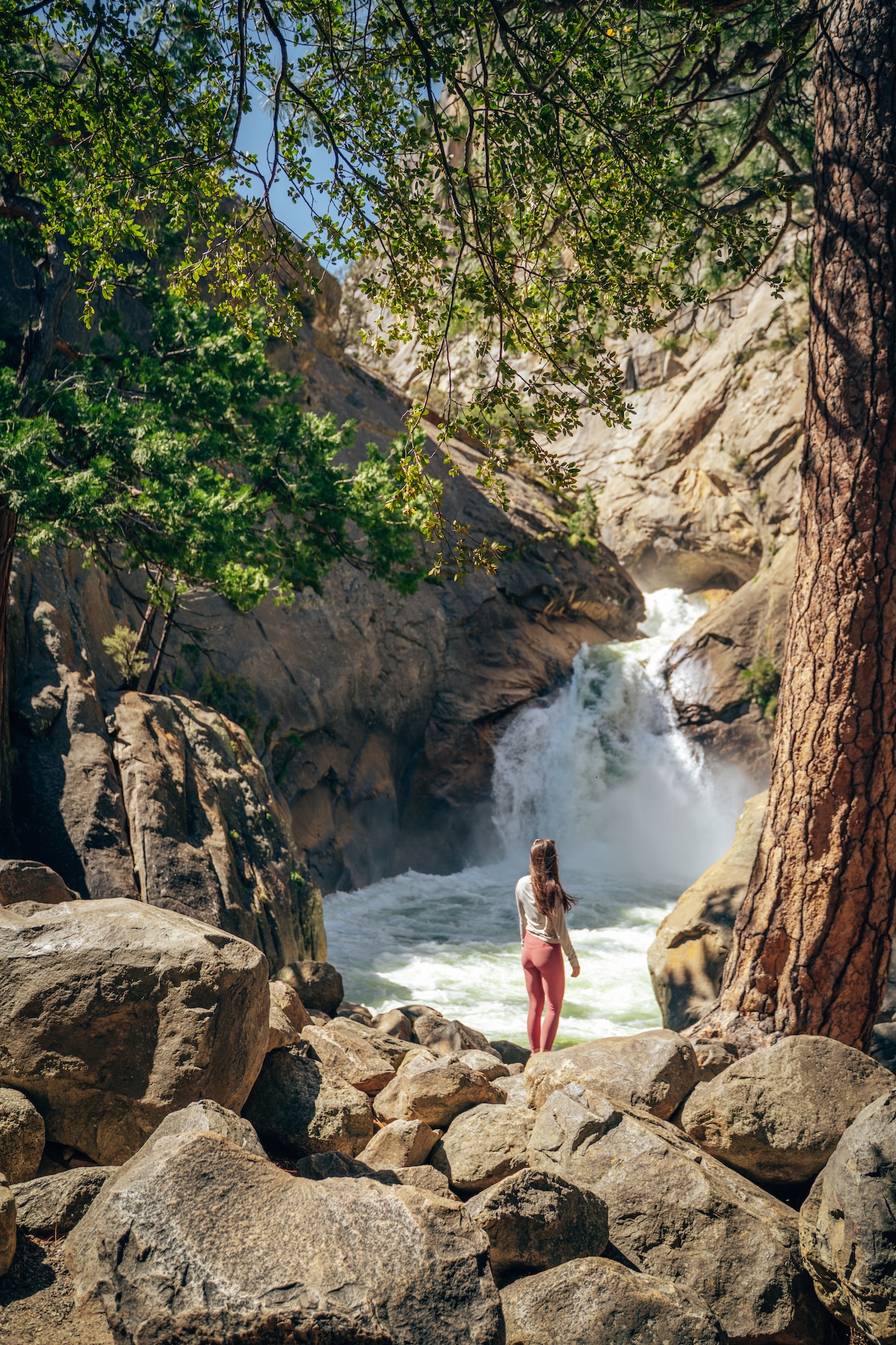
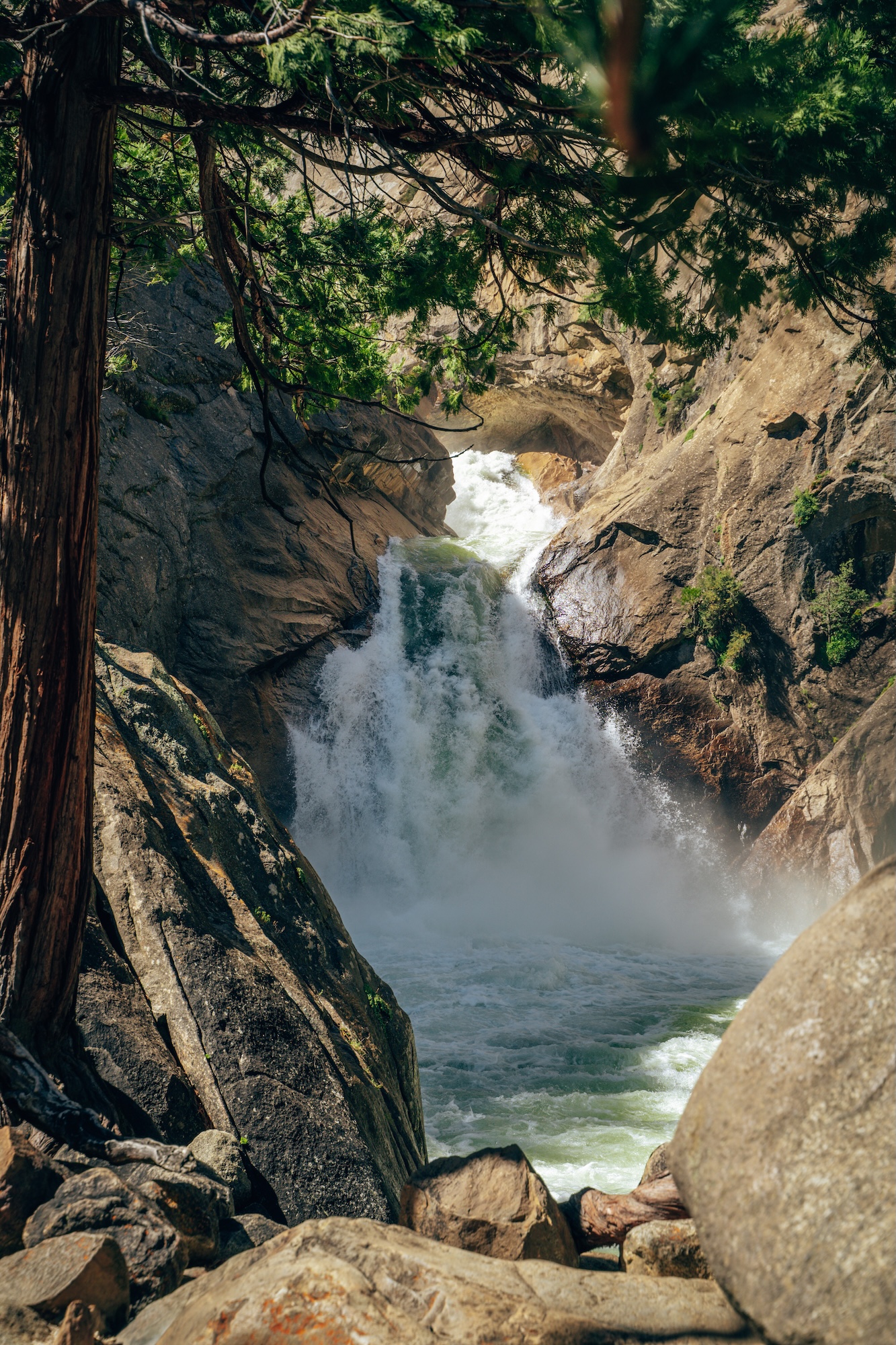
Next stop: Roaring River Falls. This waterfall is a must-see stop near the end of the Kings Canyon Scenic Byway, known for its power and accessibility. A short, paved 0.3-mile trail leads to a dramatic granite chute where the river thunders through a narrow gap. The force of the water—especially in spring—is loud, misty, and mesmerizing. Surrounded by cliffs and forest, the viewing area offers a great spot to sit, cool off, and take in the scenery. It’s easy to reach and perfect for families or anyone looking for a quick nature fix without a big hike.
- DIFFICULTY – Easy
- LENGTH – 0.3mi / 0.5km loop
- TIME NEEDED – 30 minutes
- PET FRIENDLY – NO
ZUMWALT MEADOW
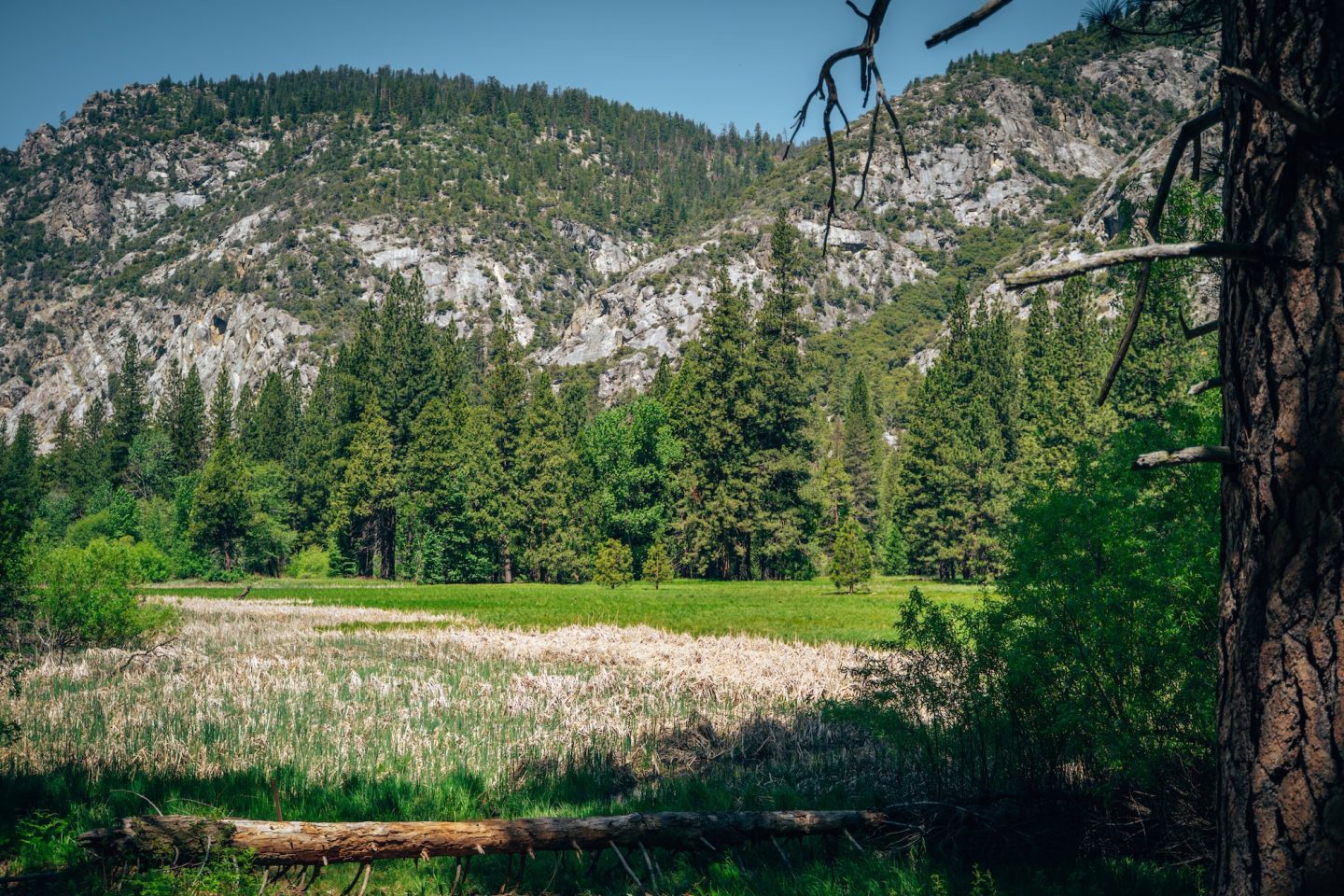
Next up, Zumwalt Meadow is one of the most scenic and peaceful spots in Kings Canyon, offering a close-up look at the park’s diverse beauty. The 1.5-mile out and back trail winds through lush meadows, shady forest, and along the banks of the Kings River, all framed by towering granite walls. This was once a looped trail, but due to damage to a section of the trail, it is (as of June 2025) an out and back trail. In late spring and early summer, wildflowers bloom and the meadow turns a vibrant green. The trail is mostly flat, though parts may be uneven or rocky near the boardwalk section. It’s a perfect choice for a relaxing walk with big visual payoff—especially early in the day when it’s quiet and calm.
- DIFFICULTY – Moderate
- LENGTH – 1.5mi / 2.4km loop
- TIME NEEDED – 30-60 minutes
- PET FRIENDLY – NO
At this point, you’ll reach the end of Highway 180 and the Kings Canyon Scenic Byway, at which point you can turn around and make your way back towards Grant Grove.
BIG STUMP
Big Stump is a lesser-known but fascinating stop near the Grant Grove entrance, where you can walk among remnants of historic logging. The short Big Stump Trail leads through a quiet forest dotted with massive sequoia stumps, telling the story of the area’s 19th-century logging era. The highlight is the Mark Twain Stump, where you can stand atop the remains of a giant tree once felled for display in the 1890s. It’s a thought-provoking and scenic walk, offering a different perspective on the park’s history and the resilience of its forests.
- DIFFICULTY – Moderate
- LENGTH – 1.7mi / 2.74km loop
- TIME NEEDED – 1-1.5 hours
- PET FRIENDLY – NO
SEQUOIA NATIONAL PARK
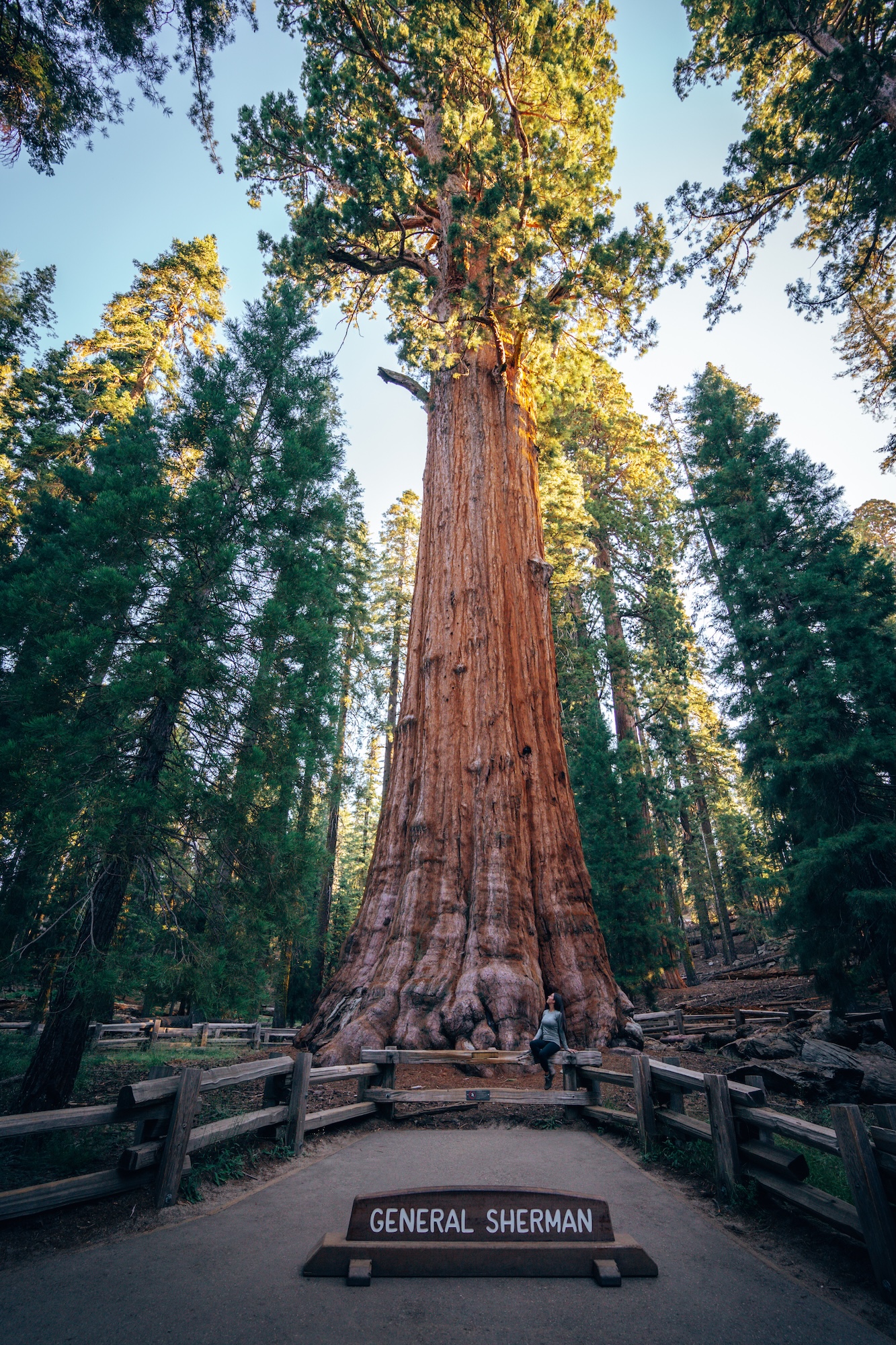
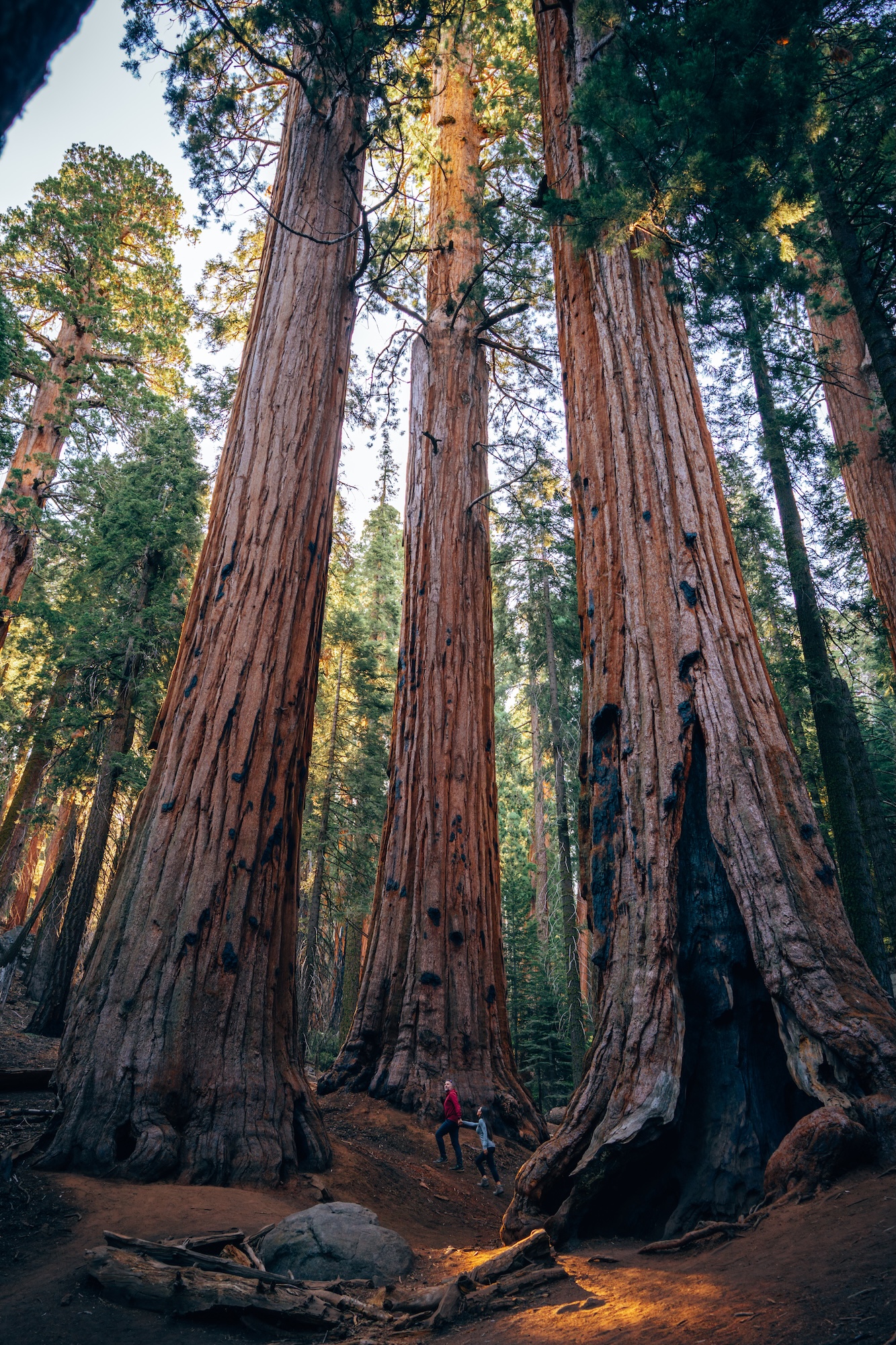
If you’re planning to stay in Three Rivers (which we would recommend doing), then this would be an easy stop on your way in to town. And an absolute must. You already saw General Grant, the second largest tree in the world, why not see THE largest tree in the world: General Sherman. The General Sherman Trail is an easy 1-mile trail in Sequoia National Park that takes you up to this giant sequoia. And if you have extra time, you can continue on from there and do a portion of the Congress Trail.
HOW TO SPEND ONE DAY IN KINGS CANYON NATIONAL PARK
Even with just one day, Kings Canyon delivers an unforgettable mix of towering trees, dramatic canyon views, and peaceful river walks. Whether you’re driving the scenic byway, standing beneath the General Grant Tree, or cooling off at Roaring River Falls, the park offers a deep sense of wonder and solitude. With thoughtful planning and an early start, you can experience some of the best this wild and underrated national park has to offer—leaving you inspired to return and explore even more.
MAP OF CALIFORNIA
Want to see ALL of the different things to do in Kings Canyon National Park? If so, this map is for you. Not only does our interactive map of California have ALL the details and location info for the locations and activities in this article, but it also has over 600 other points of interest in California in it. With all of the location specific details and information like GPS location, dog-friendliness, cost, and more, as well as an itinerary creator, this map is the perfect trip planning companion.
Not much of a planner? No worries! We also have curated itineraries to make the planning process easier for you. And if that isn’t enough, book a call with us or have us create a custom itinerary for you! We are here to help!
LOOKING FOR MORE CALIFORNIA INSPIRATION?
Looking for more California inspiration? Check out some of our other California blog articles!

